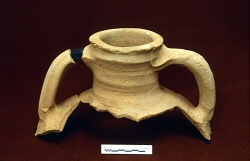Excavation at Bantham, South Devon and Post-Roman trade in south-west England
Stephen Reed, Paul Bidwell, 2007. https://doi.org/10.5284/1000305. How to cite using this DOI
Data copyright © Exeter Archaeology unless otherwise stated
This work is licensed under the ADS Terms of Use and Access.
Primary contact
Dr
John
Allan
Exeter Archaeology
The Custom House
The Quay
Exeter
EX2 4AN
England
Resource identifiers
- ADS Collection: 763
- DOI:https://doi.org/10.5284/1000305
- How to cite using this DOI
Introduction

Excavation at Bantham Ham in 2001 examined occupation which yielded radiocarbon dates centring on the late 5th and early 6th centuries. Despite the limited area of exposure, a major and unusually well-preserved assemblage of post-Roman Mediterranean amphorae was recovered. Study of well-preserved bone, shell, charcoal and charred plant macrofossils allows consideration of aspects of the economy and environment of the site.
A report on the excavations, incorporating summaries of the specialist reports, is to be submitted to the journal Medieval Archaeology. The full texts of the specialist reports are offered here.





